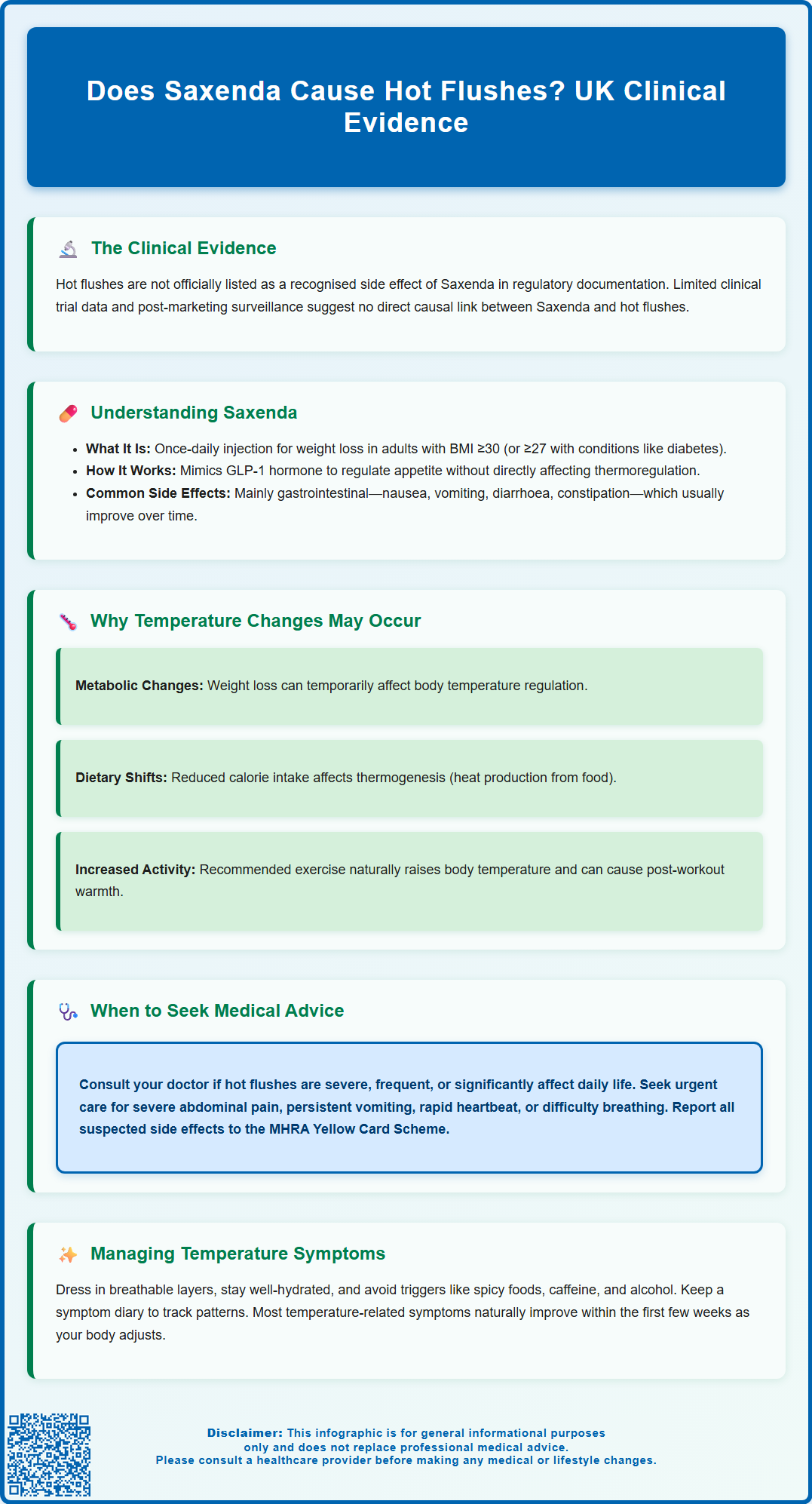Mounjaro®
Dual-agonist support that helps curb appetite, hunger, and cravings to drive substantial, sustained weight loss.
- ~22.5% average body weight loss
- Significant weight reduction
- Improves blood sugar levels
- Clinically proven weight loss

Does Saxenda cause hot flushes? Many patients taking Saxenda (liraglutide 3.0 mg) for weight management wonder about this potential side effect. Hot flushes are not listed as a recognised adverse reaction in official UK regulatory guidance from the MHRA or EMA. However, some individuals report experiencing warmth, flushing, or temperature fluctuations during treatment. These sensations may relate to metabolic changes during weight loss, dietary adjustments, or other factors rather than the medication itself. Understanding the distinction between direct drug effects and secondary physiological changes is essential for appropriate symptom management and clinical decision-making.
Summary: Hot flushes are not a recognised side effect of Saxenda according to MHRA and EMA guidance, though some patients report temperature sensations that may relate to metabolic changes during weight loss rather than the medication itself.
Hot flushes (also known as hot flashes) are not listed as a recognised side effect of Saxenda (liraglutide 3.0 mg) in the official Summary of Product Characteristics approved by the Medicines and Healthcare products Regulatory Agency (MHRA) or the European Medicines Agency (EMA). However, some patients taking Saxenda for weight management have reported experiencing sensations of warmth, flushing, or temperature fluctuations during treatment.
It is important to distinguish between a direct pharmacological effect of the medication and secondary changes that may occur during weight loss therapy. While there appears to be limited evidence of a causal association between Saxenda and hot flushes based on clinical trial data and post-marketing surveillance, the sensations some patients describe may relate to the body's metabolic adjustments during significant weight reduction, changes in dietary patterns, or other concurrent factors rather than the medication itself.
Saxenda works by mimicking the action of glucagon-like peptide-1 (GLP-1), a naturally occurring hormone that regulates appetite and food intake. Its mechanism of action primarily affects the gastrointestinal system and appetite centres in the brain, rather than directly influencing thermoregulation or hormonal pathways typically associated with hot flushes. If you are experiencing hot flushes or unusual temperature sensations whilst taking Saxenda, it is advisable to discuss these symptoms with your GP or prescribing clinician to rule out other potential causes and ensure appropriate management.
Saxenda (liraglutide 3.0 mg) is a prescription-only medicine licensed in the UK for weight management in adults with a body mass index (BMI) of 30 kg/m² or greater, or 27 kg/m² or greater in the presence of weight-related comorbidities such as type 2 diabetes, hypertension, or dyslipidaemia. It is administered as a once-daily subcutaneous injection and should be used alongside a reduced-calorie diet and increased physical activity.
The medication belongs to the GLP-1 receptor agonist class and works by slowing gastric emptying, reducing appetite, and promoting feelings of fullness. The most commonly reported side effects of Saxenda are gastrointestinal in nature and include:
Nausea (affecting more than 1 in 10 patients)
Vomiting and diarrhoea (very common, particularly during dose escalation)
Constipation
Abdominal pain or discomfort
Dyspepsia (indigestion)
These gastrointestinal symptoms typically diminish over time as the body adjusts to the medication. Saxenda is initiated at a low dose (0.6 mg daily) and gradually increased over five weeks to the maintenance dose of 3.0 mg daily to minimise these effects.
Other recognised side effects include injection site reactions, headache, dizziness, fatigue, and hypoglycaemia (particularly in patients taking diabetes medications such as sulfonylureas or insulin, where dose reduction may be needed). Increased heart rate is a common side effect. Gallbladder problems including gallstones (cholelithiasis) are common, while inflammation of the gallbladder (cholecystitis) is uncommon. Pancreatitis is an uncommon but serious adverse effect.
Saxenda should not be used during pregnancy or breastfeeding and should be stopped if pregnancy occurs. Treatment should be discontinued if a patient has not lost at least 5% of their initial body weight after 12 weeks on the full 3.0 mg dose. Patients should maintain adequate hydration during treatment, as vomiting and diarrhoea can lead to dehydration and potential kidney problems.

Whilst hot flushes are not a documented side effect of Saxenda itself, several physiological mechanisms may potentially explain why some individuals experience temperature-related symptoms during treatment, though these associations remain hypothetical.
Metabolic rate adjustments occur naturally during significant weight reduction. As body composition changes and fat stores are mobilised, the body's thermoregulatory systems may temporarily fluctuate. This can manifest as sensations of warmth, sweating, or feeling overheated, particularly during periods of rapid weight loss. These sensations are generally transient and reflect the body's adaptation to a new metabolic state.
Hormonal fluctuations may also play a role, especially in perimenopausal or menopausal women. Weight loss can influence oestrogen levels, as adipose tissue is a site of oestrogen production and storage. It's worth noting that weight loss itself—regardless of the method—can influence hormonal balance. Interestingly, research suggests that weight loss often improves rather than worsens vasomotor symptoms in many women, though individual responses vary considerably.
Dietary changes accompanying Saxenda treatment may contribute to temperature sensations. Reduced caloric intake, altered macronutrient composition, or changes in meal timing can affect thermogenesis (heat production from food metabolism). Some patients may also experience increased sensitivity to environmental temperature as their body adjusts to lower energy intake.
Increased physical activity, which is recommended alongside Saxenda therapy, naturally raises core body temperature and can lead to post-exercise warmth or flushing. Additionally, some individuals may experience anxiety or stress related to lifestyle changes, which can trigger sympathetic nervous system responses including sweating and feelings of warmth. Understanding these potential mechanisms can help patients and clinicians contextualise temperature-related symptoms during weight management treatment.
Whilst many side effects of Saxenda are mild and self-limiting, certain symptoms warrant prompt medical evaluation. Patients should be advised to contact their GP or prescribing clinician if they experience any concerning or persistent adverse effects.
Seek urgent medical attention if you develop:
Severe abdominal pain that does not resolve, particularly if radiating to the back, which may indicate pancreatitis
Persistent nausea and vomiting preventing adequate fluid intake, risking dehydration
Signs of gallbladder disease including right upper quadrant pain, jaundice (yellowing of skin or eyes), dark urine, or pale stools
Symptoms of severe allergic reaction such as difficulty breathing, facial swelling, or widespread rash
Rapid or irregular heartbeat, chest pain, or palpitations
Signs of severe hypoglycaemia (in patients taking diabetes medications) including confusion, sweating, tremor, or loss of consciousness
If you suspect a serious side effect, stop Saxenda and seek urgent medical advice; do not restart without clinical guidance. Call 999 for severe chest pain or breathing difficulty, or use NHS 111 for urgent advice when needed.
Regarding hot flushes or temperature-related symptoms specifically, you should consult your doctor if:
Hot flushes are severe, frequent, or significantly impacting quality of life
You experience night sweats requiring clothing or bedding changes
Temperature symptoms are accompanied by unexplained weight loss (beyond expected treatment effects), fatigue, or other systemic symptoms
You have a personal or family history of thyroid disease, as thyroid dysfunction can cause temperature dysregulation
Symptoms persist beyond the initial adjustment period (typically 4–8 weeks)
Your clinician can perform appropriate investigations to exclude other causes such as thyroid disorders, menopausal transition, infections, or other medical conditions. They may also review your medication regimen to identify potential drug interactions or consider whether Saxenda remains the most appropriate treatment option for you.
You can report any suspected side effects to the MHRA Yellow Card Scheme at yellowcard.mhra.gov.uk or via the Yellow Card app.
If you experience hot flushes or temperature-related symptoms whilst taking Saxenda, several practical strategies may help manage these sensations and improve comfort during treatment.
Lifestyle modifications can be particularly effective:
Dress in layers using breathable, natural fabrics such as cotton or linen that can be easily removed when feeling warm
Maintain a cool environment by using fans, opening windows, or adjusting room temperature, particularly at night
Stay well-hydrated by drinking adequate water throughout the day, which supports thermoregulation and helps prevent dehydration
Avoid known triggers such as spicy foods, caffeine, alcohol, and hot beverages, which can exacerbate vasomotor symptoms
Practice stress-reduction techniques including deep breathing exercises, mindfulness, or gentle yoga, as stress can trigger temperature fluctuations
Optimising your Saxenda regimen may also help. Ensure you are following the recommended dose escalation schedule, as gradual titration minimises side effects. Take your injection at a consistent time each day as recommended in the product information. Maintain regular meal patterns and avoid prolonged fasting, which can affect metabolic stability.
Monitor and document your symptoms using a diary to identify patterns or triggers. Note the frequency, severity, and timing of hot flushes, along with associated activities, foods, or stressors. This information can be valuable when discussing symptoms with your healthcare provider.
If temperature symptoms are related to menopausal transition, your GP may discuss additional management options appropriate to your individual circumstances, following NICE guidance on menopause management. For some patients, addressing underlying factors such as sleep quality, nutritional adequacy, or stress management can significantly improve symptom control. Remember that many adjustment symptoms improve naturally within the first few weeks of treatment as your body adapts to both the medication and the lifestyle changes accompanying weight management therapy.
No, hot flushes are not listed as a recognised side effect in the official Summary of Product Characteristics approved by the MHRA or EMA. Temperature sensations some patients experience may relate to metabolic changes during weight loss rather than the medication itself.
The most common side effects are gastrointestinal, including nausea (affecting more than 1 in 10 patients), vomiting, diarrhoea, constipation, and abdominal discomfort. These typically diminish as the body adjusts during the five-week dose escalation period.
Consult your GP if hot flushes are severe, frequent, significantly impact quality of life, persist beyond 4–8 weeks, or are accompanied by unexplained symptoms such as fatigue or night sweats requiring investigation of other potential causes.
The health-related content published on this site is based on credible scientific sources and is periodically reviewed to ensure accuracy and relevance. Although we aim to reflect the most current medical knowledge, the material is meant for general education and awareness only.
The information on this site is not a substitute for professional medical advice. For any health concerns, please speak with a qualified medical professional. By using this information, you acknowledge responsibility for any decisions made and understand we are not liable for any consequences that may result.
Lorem ipsum dolor sit amet, consectetur adipiscing elit, sed do eiusmod tempor incididunt ut labore et dolore magna aliqua. Ut enim ad minim veniam, quis nostrud exercitation ullamco laboris nisi ut aliquip ex ea commodo consequat. Duis aute irure dolor in reprehenderit in voluptate velit esse cillum dolore eu fugiat nulla pariatur.
Block quote
Ordered list
Unordered list
Bold text
Emphasis
Superscript
Subscript